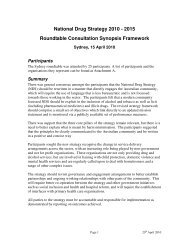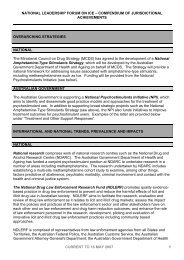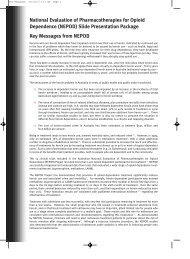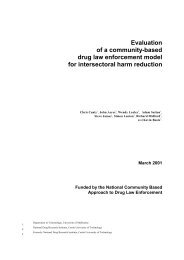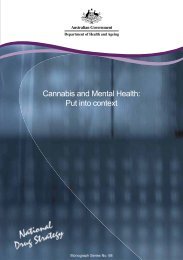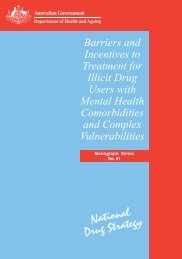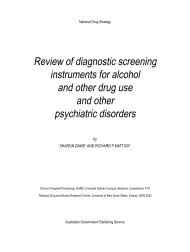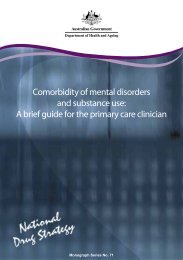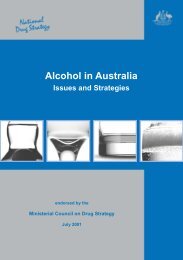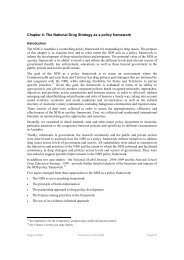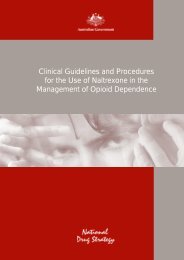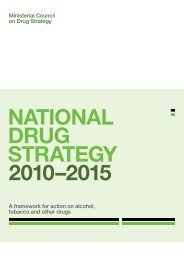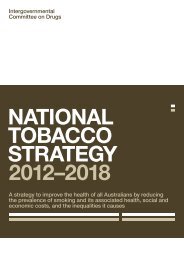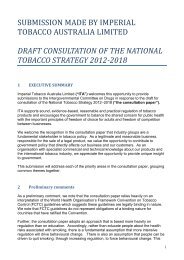The costs of tobacco, alcohol and illicit drug abuse to Australian ...
The costs of tobacco, alcohol and illicit drug abuse to Australian ...
The costs of tobacco, alcohol and illicit drug abuse to Australian ...
Create successful ePaper yourself
Turn your PDF publications into a flip-book with our unique Google optimized e-Paper software.
<strong>The</strong> <strong>costs</strong> <strong>of</strong> <strong><strong>to</strong>bacco</strong>, <strong>alcohol</strong><br />
<strong>and</strong> <strong>illicit</strong> <strong>drug</strong> <strong>abuse</strong> <strong>to</strong> <strong>Australian</strong><br />
society in 2004/05<br />
Summary version<br />
Monograph Series No. 66
<strong>The</strong> <strong>costs</strong> <strong>of</strong> <strong><strong>to</strong>bacco</strong>, <strong>alcohol</strong><br />
<strong>and</strong> <strong>illicit</strong> <strong>drug</strong> <strong>abuse</strong> <strong>to</strong><br />
<strong>Australian</strong> society in 2004/05<br />
Summary version<br />
by<br />
David J. Collins<br />
Macquarie University<br />
<strong>and</strong><br />
Helen M. Lapsley<br />
University <strong>of</strong> Queensl<strong>and</strong><br />
<strong>and</strong><br />
University <strong>of</strong> New South Wales
ii<br />
<strong>The</strong> <strong>costs</strong> <strong>of</strong> <strong><strong>to</strong>bacco</strong>, <strong>alcohol</strong> & <strong>illicit</strong> <strong>drug</strong> <strong>abuse</strong> <strong>to</strong> Aust. society in 2004/05- Summary<br />
ISBN: 1-74186-523-9<br />
Online ISBN: 1-74186-524-7<br />
Publications Number: P3 - 3226<br />
Copyright Statements:<br />
Paper-based publications<br />
(c) Commonwealth <strong>of</strong> Australia 2008<br />
This work is copyright. Apart from any use as permitted under the Copyright Act 1968,<br />
no part may be reproduced by any process without prior written permission from the<br />
Commonwealth. Requests <strong>and</strong> inquiries concerning reproduction <strong>and</strong> rights should<br />
be addressed <strong>to</strong> the Commonwealth Copyright Administration, At<strong>to</strong>rney-General’s<br />
Department, Robert Garran Offices, National Circuit, Bar<strong>to</strong>n ACT 2600 or posted<br />
at http://www.ag.gov.au/cca<br />
Internet sites<br />
(c) Commonwealth <strong>of</strong> Australia 2008<br />
This work is copyright. You may download, display, print <strong>and</strong> reproduce this material in<br />
unaltered form only (retaining this notice) for your personal, non-commercial use or use<br />
within your organisation. Apart from any use as permitted under the Copyright Act 1968,<br />
all other rights are reserved. Requests <strong>and</strong> inquiries concerning reproduction <strong>and</strong> rights<br />
should be addressed <strong>to</strong> Commonwealth Copyright Administration, At<strong>to</strong>rney-General’s<br />
Department, Robert Garran Offices, National Circuit, Bar<strong>to</strong>n ACT 2600 or posted<br />
at http://www.ag.gov.au/cca
iii<br />
Contents<br />
List <strong>of</strong> tables<br />
iv<br />
1 Introduction 1<br />
2 Interpreting the results 2<br />
3 Aggregate results 3<br />
<strong>The</strong> <strong>to</strong>tal social <strong>costs</strong> <strong>of</strong> <strong>drug</strong> <strong>abuse</strong> 3<br />
<strong>The</strong> budgetary implications <strong>of</strong> <strong>drug</strong> <strong>abuse</strong> 5<br />
4 Some disaggregated <strong>costs</strong> 7<br />
Crime 7<br />
Health 8<br />
Productivity 11<br />
5 Comparability with previous social cost estimates 13<br />
References 15<br />
List <strong>of</strong> tables in the full report 16
iv<br />
List <strong>of</strong> Tables<br />
Table 1, Total social <strong>costs</strong> <strong>of</strong> <strong>drug</strong> <strong>abuse</strong>, 2004/05 3<br />
Table 2, Tangible social <strong>costs</strong> <strong>of</strong> <strong>drug</strong> <strong>abuse</strong>, 2004/05 4<br />
Table 3, Intangible social <strong>costs</strong> <strong>of</strong> <strong>drug</strong> <strong>abuse</strong>, 2004/05 5<br />
Table 4, Summary <strong>of</strong> selected <strong>drug</strong>-attributable crime <strong>costs</strong>, 2004/05 8<br />
Table 5, Health care <strong>costs</strong> <strong>and</strong> savings resulting from <strong>drug</strong> <strong>abuse</strong>, 2004/05 9<br />
Table 6,<br />
Tobacco-attributable deaths, hospital bed-days <strong>and</strong> hospital <strong>costs</strong>,<br />
2004/05, by age <strong>and</strong> smoking status 10<br />
Table 7, Individual <strong>drug</strong> categories, summary <strong>of</strong> health outcomes, 2004/05, persons 11<br />
Table 8, Paid <strong>and</strong> unpaid production <strong>costs</strong> <strong>of</strong> <strong>drug</strong> <strong>abuse</strong>, 2004/05 12<br />
Table 9,<br />
Comparison <strong>of</strong> constant price estimates <strong>of</strong> the social <strong>costs</strong> <strong>of</strong> <strong><strong>to</strong>bacco</strong>,<br />
1998/99 <strong>and</strong> 2004/05, at 2004/05 prices 14<br />
Table 10, Comparison <strong>of</strong> constant price estimates <strong>of</strong> the social <strong>costs</strong> <strong>of</strong> <strong>illicit</strong> <strong>drug</strong>s,<br />
1998/99 <strong>and</strong> 2004/05, at 2004/05 prices 14
1 Introduction<br />
This booklet summarises the results <strong>of</strong> a study by Collins <strong>and</strong> Lapsley (2007) that estimates<br />
the social <strong>costs</strong> <strong>of</strong> <strong>drug</strong> <strong>abuse</strong> in Australia in the financial year 2004/05, with ‘<strong>drug</strong>s’<br />
including <strong>alcohol</strong>, <strong><strong>to</strong>bacco</strong> <strong>and</strong> <strong>illicit</strong> <strong>drug</strong>s. <strong>The</strong> study is the fourth in a series prepared for<br />
the Department <strong>of</strong> Health <strong>and</strong> Ageing by these authors; previous studies were undertaken<br />
for 1988, 1992 <strong>and</strong> the financial year 1998/99.<br />
<strong>The</strong> full report examines the study’s methods, concentrating on the economic aspects, with<br />
three appendixes detailing the demographic, epidemiological <strong>and</strong> criminological methods<br />
used. Bibliographical details <strong>of</strong> the full report, <strong>and</strong> a list <strong>of</strong> all tables that it contains, can be<br />
found at the end <strong>of</strong> this booklet.<br />
<strong>The</strong> different uses <strong>of</strong> substance <strong>abuse</strong> cost estimates are discussed in some detail in the<br />
World Health Organization publication International guidelines for estimating the <strong>costs</strong> <strong>of</strong><br />
substance <strong>abuse</strong> (Single et al. 2003):<br />
First, economic cost estimates are frequently used <strong>to</strong> argue that policies on<br />
<strong>alcohol</strong>, <strong><strong>to</strong>bacco</strong> <strong>and</strong> other <strong>drug</strong>s should be given a high priority on the public<br />
policy agenda...<br />
Second, cost estimates help <strong>to</strong> appropriately target specific problems <strong>and</strong> policies.<br />
It is important <strong>to</strong> know which psychoactive substances involve the greatest<br />
economic <strong>costs</strong>...<br />
Third, economic cost studies help <strong>to</strong> identify information gaps, research needs <strong>and</strong><br />
desirable refinements <strong>to</strong> national statistical reporting systems...<br />
Last but not least, the development <strong>of</strong> improved estimates <strong>of</strong> the <strong>costs</strong> <strong>of</strong><br />
substance <strong>abuse</strong> <strong>of</strong>fers the potential <strong>to</strong> provide baseline measures <strong>to</strong> determine<br />
the efficacy <strong>of</strong> <strong>drug</strong> policies <strong>and</strong> programmes intended <strong>to</strong> reduce the damaging<br />
consequences <strong>of</strong> <strong>alcohol</strong>, <strong><strong>to</strong>bacco</strong> <strong>and</strong> other <strong>drug</strong> use. Estimates <strong>of</strong> the social<br />
<strong>costs</strong> can assist policy makers in evaluating outcomes, as expressed in terms <strong>of</strong><br />
changes in social <strong>costs</strong> in constant dollar terms. Estimates <strong>of</strong> social <strong>costs</strong> can also<br />
facilitate cross-national comparisons <strong>of</strong> the consequences <strong>of</strong> substance <strong>abuse</strong> <strong>and</strong><br />
different approaches <strong>to</strong> confronting those consequences.<br />
<strong>The</strong> purpose <strong>of</strong> the research summarised here was <strong>to</strong> provide reliable estimates that could<br />
inform all <strong>of</strong> these public policy objectives.
2 Interpreting the results<br />
<strong>The</strong> definition <strong>of</strong> the economic <strong>costs</strong> <strong>of</strong> <strong>drug</strong> <strong>abuse</strong> used in the three previous Collins <strong>and</strong><br />
Lapsley studies, <strong>and</strong> for the present study, is:<br />
the value <strong>of</strong> the net resources that in a given year are unavailable <strong>to</strong> the<br />
community for consumption or investment purposes as a result <strong>of</strong> the effects <strong>of</strong><br />
past <strong>and</strong> present <strong>drug</strong> <strong>abuse</strong>, plus the intangible <strong>costs</strong> imposed by this <strong>abuse</strong><br />
This cost concept, which applies <strong>to</strong> what has been labelled the demographic approach, is<br />
based on the calculation <strong>of</strong> the size <strong>and</strong> structure <strong>of</strong> a hypothetical population in which no<br />
<strong>drug</strong> <strong>abuse</strong> had occurred. This hypothetical population is then compared with the actual<br />
population size <strong>and</strong> structure, as a basis for estimating <strong>drug</strong> <strong>abuse</strong> <strong>costs</strong>.<br />
Thus, for the purposes <strong>of</strong> this study, the counterfactual (that is the hypothetical) situation<br />
that is compared <strong>to</strong> the actual 2004/05 <strong>drug</strong> <strong>abuse</strong> situation is one in which there has<br />
been no <strong>abuse</strong> <strong>of</strong> the <strong>drug</strong> in question for an extended period <strong>of</strong> time. <strong>The</strong> study in effect<br />
estimates the social <strong>costs</strong> that were borne in the financial year 2004/05 <strong>and</strong> that resulted<br />
from all <strong>drug</strong> <strong>abuse</strong> in 2004/05 <strong>and</strong> in previous years.
3 Aggregate results<br />
<strong>The</strong> <strong>to</strong>tal social <strong>costs</strong> <strong>of</strong> <strong>drug</strong> <strong>abuse</strong><br />
This section summarises the overall social <strong>costs</strong> <strong>of</strong> <strong>drug</strong> <strong>abuse</strong>, classified by type <strong>of</strong> <strong>drug</strong>.<br />
Table 1 summaries the <strong>to</strong>tal <strong>costs</strong>. Commentary on the <strong>costs</strong> attributable <strong>to</strong> individual <strong>drug</strong>s<br />
is complicated by the joint nature <strong>of</strong> some crime <strong>costs</strong>. It is also complicated by the need <strong>to</strong><br />
adjust for interactive effects arising when some health conditions are causally related <strong>to</strong> the<br />
consumption <strong>of</strong> both <strong>alcohol</strong> <strong>and</strong> <strong><strong>to</strong>bacco</strong>.<br />
Table 1, Total social <strong>costs</strong> <strong>of</strong> <strong>drug</strong> <strong>abuse</strong>, 2004/05<br />
Alcohol<br />
($m)<br />
Tobacco<br />
($m)<br />
Illicit<br />
<strong>drug</strong>s<br />
($m)<br />
Alcohol<br />
<strong>and</strong> <strong>illicit</strong>s<br />
<strong>to</strong>gether<br />
($m)<br />
All <strong>drug</strong>s<br />
($m)<br />
All <strong>drug</strong>s<br />
adjusted<br />
for health<br />
interaction<br />
($m)<br />
Tangible 10,829.5 12,026.2 6,915.4 1,057.8 30,828.9 30,489.8<br />
Intangible 4,488.7 19,459.7 1,274.5 25,222.9 24,683.0<br />
Total 15,318.2 31,485.9 8,189.8 1,057.8 56,051.8 55,172.8<br />
Proportion <strong>of</strong><br />
unadjusted <strong>to</strong>tal 27.3% 56.2% 14.6% 1.9% 100.0%<br />
Notes: Health-related cost components in final column have been adjusted by 2.18% <strong>to</strong> take account <strong>of</strong><br />
<strong>drug</strong>s interaction. As a result <strong>of</strong> rounding, <strong>to</strong>tals may not correspond exactly with the sums <strong>of</strong> their individual<br />
components.<br />
Of the <strong>to</strong>tal social <strong>costs</strong> <strong>of</strong> <strong>drug</strong> <strong>abuse</strong> in 2004/05 <strong>of</strong> $55.2 billion, <strong>alcohol</strong> accounted for<br />
$15.3 billion (27.3 per cent <strong>of</strong> the unadjusted <strong>to</strong>tal), <strong><strong>to</strong>bacco</strong> $31.5 billion (56.2 per cent) <strong>and</strong><br />
<strong>illicit</strong> <strong>drug</strong>s $8.2 billion (14.6 per cent). Alcohol <strong>and</strong> <strong>illicit</strong> <strong>drug</strong>s acting <strong>to</strong>gether accounted for<br />
another $1.1 billion (1.9 per cent).<br />
Tables 2 <strong>and</strong> 3 provide full details <strong>of</strong> the tangible <strong>and</strong> intangible cost components <strong>of</strong> <strong>to</strong>tal<br />
<strong>costs</strong>. As is explained in Section 4 below, care needs <strong>to</strong> be taken <strong>to</strong> avoid double counting<br />
some <strong>of</strong> the tangible <strong>costs</strong> <strong>of</strong> crime. Accordingly, for comprehensive estimates <strong>of</strong> aggregate<br />
crime <strong>costs</strong>, readers should consult Section 4.
Table 2, Tangible social <strong>costs</strong> <strong>of</strong> <strong>drug</strong> <strong>abuse</strong>, 2004/05<br />
Labour in the workforce<br />
Alcohol<br />
($m)<br />
Tobacco<br />
($m)<br />
Illicit <strong>drug</strong>s<br />
($m)<br />
Alcohol <strong>and</strong><br />
<strong>illicit</strong>s<br />
<strong>to</strong>gether<br />
($m)<br />
Total<br />
($m)<br />
Total adjusted<br />
for interaction<br />
Reduction in<br />
workforce 3,210.7 4,969.5 889.4 9,069.5 8,872.1<br />
Absenteeism 367.9 779.6 733.5 1,880.9 1,840.0<br />
Total 3,578.6 5,749.1 1,622.9 10,950.5 10,712.1<br />
Labour in the household<br />
Premature death 1,423.9 9,156.4 458.5 11,038.8 10,798.5<br />
Sickness 146.9 686.7 37.0 870.6 851.7<br />
Total 1,570.8 9,843.1 495.5 11,909.4 11,650.2<br />
Total paid <strong>and</strong> unpaid labour<br />
<strong>costs</strong> 5,149.4 15,592.2 2,118.3 22,859.9 22,362.2<br />
Less consumption<br />
resources saved 1,611.3 7,583.1 469.5 9,663.9 9,453.5<br />
Total net labour <strong>costs</strong> 3,538.0 8,009.1 1,648.9 13,196.0 12,908.7<br />
Healthcare (net)<br />
Medical 540.7 158.4 104.7 803.8 786.3<br />
Hospital 662.2 223.4 86.5 972.1 950.9<br />
Nursing homes 401.2 (177.3) 6.2 230.1 225.1<br />
Pharmaceuticals 297.6 77.3 375.0 366.8<br />
Ambulances 74.8 36.6 4.4 115.8 115.8<br />
Total healthcare 1,976.7 318.4 201.7 2,496.8 2,445.0<br />
Road accidents n.e.i. 2,202.0 527.6 2,729.6 2,729.6<br />
Fires n.e.i. 63.0 63.0 63.0<br />
Crime n.e.i.<br />
Police 747.1 1,716.9 320.2 2,784.2 2,784.2<br />
Criminal courts 85.8 146.8 28.0 260.7 260.7<br />
Prisons 141.8 348.6 146.6 636.9 636.9<br />
Property 67.1 445.4 144.6 657.1 657.1<br />
Insurance<br />
administration 14.3 94.6 30.7 139.6 139.6<br />
Productivity <strong>of</strong><br />
prisoners 368.0 892.1 387.7 1,647.9 1,647.9<br />
Total crime 1,424.0 3,644.5 1,057.8 6,126.3 6,126.3<br />
Resources used in abusive<br />
consumption 1,688.8 3,635.6 892.7 6,217.1 6,217.1<br />
Total 10,829.5 12,026.2 6,915.4 1,057.8 30,828.9 30,489.8<br />
Proportion <strong>of</strong> <strong>to</strong>tal<br />
unadjusted tangible <strong>costs</strong> 35.1% 39.0% 22.4% 3.4% 100.0%<br />
Notes: n.e.i. = not elsewhere included. As a result <strong>of</strong> rounding, <strong>to</strong>tals may not correspond exactly with the sums<br />
<strong>of</strong> their individual components.<br />
Numbers in brackets are negative.<br />
($m)
Tangible <strong>costs</strong> attributable <strong>to</strong> <strong>alcohol</strong> in 2004/05 were $10.8 billion, <strong>to</strong> <strong><strong>to</strong>bacco</strong> were $12.0<br />
billion, <strong>and</strong> <strong>to</strong> <strong>illicit</strong> <strong>drug</strong>s were $6.9 billion. Alcohol <strong>and</strong> <strong>illicit</strong> <strong>drug</strong>s acting <strong>to</strong>gether <strong>to</strong> cause<br />
crime contributed a further $1.1 billion. Labour <strong>and</strong> health <strong>costs</strong> constituted the major cost<br />
component for <strong>alcohol</strong>. Workforce <strong>costs</strong> were a large component <strong>of</strong> <strong><strong>to</strong>bacco</strong> tangible <strong>costs</strong>.<br />
Crime <strong>costs</strong> comprised a very high proportion <strong>of</strong> <strong>illicit</strong> <strong>drug</strong> <strong>costs</strong>.<br />
Table 3, Intangible social <strong>costs</strong> <strong>of</strong> <strong>drug</strong> <strong>abuse</strong>, 2004/05<br />
Alcohol<br />
($m)<br />
Tobacco<br />
($m)<br />
Illicit<br />
<strong>drug</strong>s<br />
($m)<br />
All <strong>drug</strong>s<br />
($m)<br />
All <strong>drug</strong>s<br />
adjusted<br />
for health<br />
interaction<br />
($m)<br />
Loss <strong>of</strong> life 4,135.0 19,459.7 1,204.7 24,799.5 24,259.6<br />
Pain <strong>and</strong> suffering (road<br />
accidents) 353.6 69.7 423.4 423.4<br />
Total intangible <strong>costs</strong> 4,488.7 19,459.7 1,274.5 25,222.9 24,683.0<br />
Proportion <strong>of</strong> unadjusted<br />
<strong>to</strong>tal intangible <strong>costs</strong> 17.8% 77.2% 5.1% 100.0%<br />
For intangible <strong>costs</strong>, except for pain <strong>and</strong> suffering <strong>of</strong> road accident victims, only the value<br />
<strong>of</strong> loss <strong>of</strong> life (<strong>to</strong> be precise, the loss <strong>of</strong> a year’s living) could be estimated. Intangible<br />
<strong>alcohol</strong> <strong>costs</strong> were $4.5 billion, <strong><strong>to</strong>bacco</strong> <strong>costs</strong> $19.5 billion, <strong>and</strong> <strong>illicit</strong> <strong>costs</strong> $1.3 billion. <strong>The</strong><br />
predominance <strong>of</strong> intangible <strong>costs</strong> attributable <strong>to</strong> <strong><strong>to</strong>bacco</strong> is a direct result <strong>of</strong> the high level <strong>of</strong><br />
premature mortality caused by smoking.<br />
<strong>The</strong> budgetary implications <strong>of</strong> <strong>drug</strong> <strong>abuse</strong><br />
<strong>The</strong> full report presents estimates <strong>of</strong> the budgetary implications <strong>of</strong> <strong>drug</strong> <strong>abuse</strong> that is its<br />
impact upon public expenditures <strong>and</strong> revenues at both national <strong>and</strong> state/terri<strong>to</strong>ry levels.<br />
However, the estimates relate <strong>to</strong> the budgetary impact <strong>of</strong> <strong>drug</strong> <strong>abuse</strong>, not <strong>drug</strong> consumption.<br />
Furthermore, they incorporate estimates <strong>of</strong> the revenue losses resulting from <strong>drug</strong>-induced<br />
morbidity <strong>and</strong> premature mortality. Results are presented for the budgetary impact <strong>of</strong> <strong>drug</strong><br />
<strong>abuse</strong> for the <strong>Australian</strong> Government <strong>and</strong> state governments separately for each type <strong>of</strong><br />
<strong>drug</strong>.<br />
Alcohol tax revenue in 2004/05 exceeded <strong>alcohol</strong>-attributable <strong>costs</strong> borne by the public<br />
sec<strong>to</strong>r by $1.4 billion. <strong>The</strong> <strong>Australian</strong> Government accrued an <strong>alcohol</strong>-attributable surplus <strong>of</strong><br />
$1.8 billion, while the state governments were in deficit <strong>to</strong> the tune <strong>of</strong> $387 million.<br />
Tobacco tax revenue in 2004/05 exceeded <strong><strong>to</strong>bacco</strong>-attributable <strong>costs</strong> borne by the public<br />
sec<strong>to</strong>r by more than $3.5 billion. Of this surplus $2.7 billion accrued <strong>to</strong> the Commonwealth<br />
<strong>and</strong> around $800 million <strong>to</strong> state governments.<br />
By their nature, <strong>illicit</strong> <strong>drug</strong>s yield no tax revenue. <strong>The</strong>ir production or importation by a<br />
cl<strong>and</strong>estine industry renders taxation impossible. Indeed, overall tax revenue is reduced (by<br />
an estimated $299.5 million in 2004/05) because <strong>drug</strong>-attributable mortality <strong>and</strong> morbidity<br />
reduce revenue from general taxes on income <strong>and</strong> consumption. At the same time, the
consumption <strong>of</strong> <strong>illicit</strong> <strong>drug</strong>s imposes substantial <strong>costs</strong>, particularly crime <strong>costs</strong>, on the<br />
public sec<strong>to</strong>r. In 2004/05, public sec<strong>to</strong>r outlays attributable <strong>to</strong> <strong>illicit</strong> <strong>drug</strong>s, <strong>to</strong>gether with<br />
revenue losses amounted <strong>to</strong> almost $2.7 billion, <strong>of</strong> which 84 per cent was borne by state<br />
governments.<br />
<strong>The</strong> introduction <strong>of</strong> the GST in 1999 removed the states’ ability <strong>to</strong> tax <strong><strong>to</strong>bacco</strong> <strong>and</strong> <strong>alcohol</strong>,<br />
except through the GST, causing a significant adjustment <strong>of</strong> taxing powers between the two<br />
levels <strong>of</strong> government. <strong>The</strong> <strong>Australian</strong> Government is now the major beneficiary <strong>of</strong> the tax<br />
revenue from <strong><strong>to</strong>bacco</strong> <strong>and</strong> <strong>alcohol</strong>.
4 Some disaggregated <strong>costs</strong><br />
This section provides detailed estimates <strong>of</strong> the <strong>costs</strong> <strong>of</strong> crime, health care <strong>and</strong> production<br />
losses. It also presents information on the breakdown <strong>of</strong> the <strong>costs</strong> <strong>of</strong> <strong>illicit</strong> <strong>drug</strong>s according<br />
<strong>to</strong> the type <strong>of</strong> <strong>drug</strong>. <strong>The</strong> full report also provides detailed estimates <strong>of</strong> the <strong>costs</strong> <strong>of</strong> road<br />
accidents attributable <strong>to</strong> the consumption <strong>of</strong> <strong>alcohol</strong> <strong>and</strong> <strong>illicit</strong> <strong>drug</strong>s, <strong>and</strong> <strong>of</strong> the <strong>costs</strong> <strong>of</strong> fires<br />
attributable <strong>to</strong> smoking.<br />
<strong>The</strong> presentation used in the full report provides comprehensive information on particular<br />
areas <strong>of</strong> <strong>costs</strong> while avoiding double counting some <strong>of</strong> the <strong>costs</strong>. For example, crime <strong>costs</strong><br />
include productivity losses, for which separate aggregate <strong>drug</strong> <strong>abuse</strong> cost estimates are<br />
made. Productivity <strong>costs</strong> cannot be included in both areas without double counting, <strong>and</strong> yet<br />
<strong>to</strong> exclude them from crime <strong>costs</strong> would give the impression that the <strong>to</strong>tal <strong>costs</strong> <strong>of</strong> <strong>drug</strong>attributable<br />
crime were lower than they are. This problem is overcome in the case <strong>of</strong> crime<br />
by estimating overall <strong>costs</strong> as well as ‘not elsewhere included’ <strong>costs</strong>, which are the values<br />
carried over <strong>to</strong> the aggregate tables. In this way all double counting is avoided.<br />
Crime<br />
Table 4 below presents estimates <strong>of</strong> <strong>drug</strong>-attributable crime <strong>costs</strong>. <strong>The</strong>y are certainly<br />
substantial underestimates as a result <strong>of</strong> the considerable under-reporting <strong>of</strong> crimes<br />
<strong>to</strong> police. Some component <strong>of</strong> crime <strong>costs</strong> is causally attributable jointly <strong>to</strong> <strong>alcohol</strong> <strong>and</strong><br />
<strong>illicit</strong> <strong>drug</strong>s. It is, however, not possible <strong>to</strong> indicate what proportion <strong>of</strong> these joint <strong>costs</strong> is<br />
attributable <strong>to</strong> either <strong>alcohol</strong> individually or <strong>illicit</strong> <strong>drug</strong>s individually.
Table 4, Summary <strong>of</strong> selected <strong>drug</strong>-attributable crime <strong>costs</strong>, 2004/05<br />
Alcohol<br />
($m)<br />
Illicit <strong>drug</strong>s<br />
($m)<br />
Both<br />
($m)<br />
Tangible <strong>costs</strong><br />
Police 747.1 1,716.9 320.2<br />
Criminal courts 85.8 146.8 28.0<br />
Prisons 141.8 348.6 146.6<br />
Property 67.1 445.4 144.6<br />
Insurance administration 14.3 94.6 30.7<br />
Violence 187.5 196.1 203.2<br />
Productivity <strong>of</strong> prisoners 368.0 892.1 387.7<br />
Total tangible 1,611.5 3,840.5 1,261.0<br />
Intangible <strong>costs</strong><br />
Loss <strong>of</strong> life (violence) 124.4 130.1 134.8<br />
Total intangible <strong>costs</strong> 124.4 130.1 134.8<br />
Total <strong>costs</strong> 1,735.9 3,970.6 1,395.8<br />
Total n.e.i.<br />
Tangible 1,424.0 3,644.5 1,057.8<br />
Intangible 0.0 0.0 0.0<br />
Relevant <strong>costs</strong> as a proportion <strong>of</strong> GDP 0.20% 0.48% 0.16%<br />
Note: n.e.i. = not elsewhere included.<br />
Alcohol-attributable crime cost $1.7 billion in 2004/05 while crime attributable <strong>to</strong><br />
consumption <strong>of</strong> <strong>illicit</strong> <strong>drug</strong>s cost $4.0 billion. Crime attributable jointly <strong>to</strong> both types <strong>of</strong> <strong>drug</strong>s<br />
cost a further $1.4 billion.<br />
Health<br />
Drug-attributable morbidity imposes health care <strong>costs</strong> for medical services, hospitals,<br />
nursing homes, pharmaceuticals <strong>and</strong> ambulances. However, the premature deaths<br />
caused by <strong>drug</strong> <strong>abuse</strong> can relieve the community <strong>of</strong> some health care cost burdens. If<br />
the prematurely deceased were still alive, they would be placing dem<strong>and</strong>s on health care<br />
resources. <strong>The</strong> paper estimates these health care savings as well as the health care <strong>costs</strong>.<br />
Table 5 presents estimates <strong>of</strong> <strong>drug</strong>-attributable health care <strong>costs</strong> <strong>and</strong> savings. Note that<br />
in-patient pharmaceutical <strong>costs</strong> are incorporated in hospital <strong>costs</strong>; the pharmaceutical <strong>costs</strong><br />
identified here refer <strong>to</strong> prescribed pharmaceuticals outside the hospital system.
Table 5, Health care <strong>costs</strong> <strong>and</strong> savings resulting from <strong>drug</strong> <strong>abuse</strong>, 2004/05<br />
Medical<br />
($m)<br />
Hospitals<br />
($m)<br />
Nursing<br />
homes<br />
($m)<br />
Pharmaceuticals<br />
($m)<br />
Ambulances<br />
($m)<br />
Total<br />
Alcohol<br />
Gross <strong>costs</strong> 562.3 693.9 389.2 324.8 80.4 2,050.5<br />
Savings from<br />
21.5 31.6 (12.0) 27.2 5.5 73.9<br />
premature<br />
deaths<br />
Net <strong>costs</strong> 540.7 662.2 401.2 297.6 74.8 1,976.7<br />
Tobacco<br />
Gross <strong>costs</strong> 462.1 669.6 436.6 205.2 62.5 1,836.0<br />
Savings from<br />
303.7 446.2 613.9 127.9 25.9 1,517.6<br />
premature<br />
deaths<br />
Net <strong>costs</strong> 158.4 223.4 (177.3) 77.3 36.6 318.4<br />
Illicit <strong>drug</strong>s<br />
Gross <strong>costs</strong> 122.5 112.6 11.9 n.a. 6.0 252.9<br />
Savings from<br />
17.8 26.1 5.7 n.a. 1.6 51.2<br />
premature<br />
deaths<br />
Net <strong>costs</strong> 104.7 86.5 6.2 n.a. 4.4 201.7<br />
All <strong>drug</strong>s<br />
Gross <strong>costs</strong> 1,146.8 1,476.1 837.7 530.0 148.9 4,139.5<br />
Savings from<br />
343.0 504.0 607.6 155.0 33.0 1,642.7<br />
premature<br />
deaths<br />
Net <strong>costs</strong> 803.8 972.1 230.1 375.0 115.8 2,496.8<br />
n.a. = not available.<br />
Numbers in brackets are negative.<br />
Total <strong>drug</strong>-attributable gross health care <strong>costs</strong> in 2004/05 were $4.1 billion while net <strong>costs</strong><br />
were $2.5 billion.<br />
<strong>The</strong> study disaggregates the <strong>costs</strong> <strong>of</strong> smoking in<strong>to</strong> active <strong>and</strong> involuntary components.<br />
Medical conditions attributable <strong>to</strong> active smoking occur from smokers inflicting adverse<br />
health effects on themselves. Conditions attributable <strong>to</strong> involuntary smoking occur when<br />
smokers inflict adverse health effects on others (including the unborn). Estimates <strong>of</strong> the<br />
impact <strong>of</strong> involuntary smoking on deaths, hospital bed-days <strong>and</strong> hospital <strong>costs</strong>, classified by<br />
age, are presented in Table 6.<br />
($m)
10<br />
Table 6, Tobacco-attributable deaths, hospital bed-days <strong>and</strong> hospital <strong>costs</strong>, 2004/05,<br />
by age <strong>and</strong> smoking status<br />
Voluntary Involuntary Total<br />
Deaths (number)<br />
0–14 0.0 36 36<br />
15+ 14,753 112 14,865<br />
Total 14,753 149 14,901<br />
Hospital bed days (number)<br />
0–14 0.0 61,178 61,178<br />
15+ 689,951 2,489 692,440<br />
Total 689,951 63,667 753,618<br />
Hospital <strong>costs</strong> ($m)<br />
0–14 0.0 30.6 30.6<br />
15+ 636.0 3.1 639.1<br />
Total 636.0 33.7 669.6<br />
<strong>The</strong> above table clearly illustrates that the <strong>costs</strong> <strong>of</strong> involuntary smoking are largely<br />
imposed on the young. For children under 15 in 2004/05, involuntary smoking accounted for<br />
25 per cent <strong>of</strong> deaths, 96 per cent <strong>of</strong> hospital bed-days <strong>and</strong> 91 per cent <strong>of</strong> hospital <strong>costs</strong>.<br />
<strong>The</strong> <strong>illicit</strong> <strong>drug</strong>-attributable mortality <strong>and</strong> morbidity <strong>costs</strong> as presented in table 6 <strong>of</strong> the full<br />
report relate <strong>to</strong> <strong>illicit</strong> <strong>drug</strong>s as a whole. In reality, ‘<strong>illicit</strong> <strong>drug</strong>s’ represents a range <strong>of</strong> <strong>drug</strong>s<br />
<strong>and</strong> these <strong>costs</strong> should, wherever possible, be disaggregated <strong>to</strong> the level <strong>of</strong> individual<br />
<strong>drug</strong>s. However, the ability <strong>to</strong> disaggregate is severely limited by the scope <strong>of</strong> the available<br />
epidemiological data. It is possible <strong>to</strong> identify some <strong>of</strong> the effects <strong>of</strong> individual <strong>drug</strong>s on<br />
mortality, potential years <strong>of</strong> life lost, hospital usage <strong>and</strong> gross hospital <strong>costs</strong>. However, this<br />
does not take in<strong>to</strong> account any savings that have resulted from <strong>drug</strong>-attributable premature<br />
deaths. Table 7 summarises these effects.
11<br />
Table 7, Individual <strong>drug</strong> categories, summary <strong>of</strong> health outcomes, 2004/05, persons<br />
Deaths<br />
(number)<br />
PYLL<br />
ages 0–74<br />
(number)<br />
Hospital bed<br />
days<br />
(number)<br />
Gross hospital<br />
<strong>costs</strong><br />
($’000)<br />
Opiates 228 9,417 22,463 13,094<br />
Cannabis 1 41 7,287 3,054<br />
Amphetamines 0 0 4,710 2,618<br />
Cocaine 0 0 627 412<br />
Psychostimulants 17 806 578 740<br />
Hallucinogens 1 50 418 494<br />
Other psychotropics 3 132 129 192<br />
Anabolic steroids 0 0 0 0<br />
Other 139 4,561 122,683 68,998<br />
Licit/unspecified/combined 483 16,498 40,811 22,961<br />
Total 872 31,504 199,706 112,563<br />
Sum <strong>of</strong> identified <strong>drug</strong>s 250 10,445 36,212 20,604<br />
PYLL = potential years <strong>of</strong> life lost.<br />
As Table 7 shows, a significant proportion <strong>of</strong> the <strong>to</strong>tal impact on mortality <strong>and</strong> morbidity<br />
results from unspecified <strong>drug</strong>s . Only 28.7 per cent <strong>of</strong> <strong>to</strong>tal <strong>illicit</strong> <strong>drug</strong>-attributable deaths can<br />
be assigned <strong>to</strong> specific <strong>drug</strong>s, 33.2 per cent <strong>of</strong> potential years <strong>of</strong> life lost, 18.1 per cent <strong>of</strong><br />
hospital bed-days <strong>and</strong> 18.3 per cent <strong>of</strong> gross hospital <strong>costs</strong>.<br />
Productivity<br />
Drug <strong>abuse</strong> causes a loss <strong>of</strong> national productive capacity in the paid workforce as a result <strong>of</strong><br />
<strong>drug</strong>-attributable death <strong>and</strong> sickness. Losses are also experienced in the unpaid workforce<br />
(the household sec<strong>to</strong>r) from the same causes. Against these losses are the savings in<br />
national resources that would have been consumed if the <strong>drug</strong>-attributable deaths had not<br />
occurred. Net production losses represent the gross reduction in productive capacity less<br />
these consumption savings. Table 8 presents estimates <strong>of</strong> the reductions in productive<br />
capacity that resulted from <strong>drug</strong> <strong>abuse</strong> in 2004/05.
12<br />
Table 8, Paid <strong>and</strong> unpaid production <strong>costs</strong> <strong>of</strong> <strong>drug</strong> <strong>abuse</strong>, 2004/05<br />
Labour in the workforce<br />
Reduction in workforce<br />
Alcohol<br />
($m)<br />
Tobacco<br />
($m)<br />
Illicit<br />
<strong>drug</strong>s<br />
($m)<br />
Male 2,741.4 4,030.1 762.3<br />
Female 469.3 939.3 127.1<br />
Total<br />
($m)<br />
Proportion<br />
<strong>of</strong> gross<br />
<strong>costs</strong><br />
(%)<br />
Total reduction<br />
in workforce 3,210.7 4,969.5 889.4 9,069.5 39.7<br />
Absenteeism<br />
Male 228.5 646.9 698.9<br />
Female 139.4 132.7 34.6<br />
Total absenteeism 367.9 779.6 733.5 1,880.9 8.2<br />
Total paid production <strong>costs</strong> 3,578.6 5,749.1 1,622.9 10,950.5 47.9<br />
Labour in the household<br />
Premature death<br />
Male 1,294.4 5,806.9 314.6<br />
Female 129.5 3,349.5 143.9<br />
Total premature death 1,423.9 9,156.4 458.5 11,038.8 48.3<br />
Sickness<br />
Male 60.7 452.8 30.1<br />
Female 86.3 233.9 6.9<br />
Total sickness 146.9 686.7 37.0 870.6 3.8<br />
Total unpaid production <strong>costs</strong> 1,570.8 9,843.1 495.5 11,909.4 52.1<br />
Total paid <strong>and</strong> unpaid production <strong>costs</strong> 5,149.4 15,592.2 2,118.3 22,859.9 100.0<br />
Consumption resources saved<br />
Male 1,464.1 5,534.8 367.8<br />
Female 147.2 2,048.3 101.6<br />
Total consumption resources saved 1,611.3 7,583.1 469.5 9,663.9<br />
Total net production <strong>costs</strong> 3,538.0 8,009.1 1,648.9 13,196.0<br />
Percentage <strong>of</strong> <strong>to</strong>tal net production <strong>costs</strong> 26.8% 60.7% 12.5% 100.0%<br />
Of the <strong>to</strong>tal net production <strong>costs</strong> <strong>of</strong> $13.2 billion, <strong><strong>to</strong>bacco</strong> accounted for by far the largest<br />
share (60.7 per cent or $8.0 billion). Alcohol represented 26.8 per cent ($3.5 billion) <strong>and</strong> <strong>illicit</strong><br />
<strong>drug</strong>s 12.5 per cent ($1.6 billion). Of the gross production <strong>costs</strong> <strong>of</strong> $22.9 billion, workforce<br />
losses represented 47.9 per cent ($11.0 billion) <strong>and</strong> household losses 52.1 per cent<br />
($11.9 billion).
13<br />
5 Comparability with previous social cost<br />
estimates<br />
<strong>The</strong> authors have previously estimated the social <strong>costs</strong> <strong>of</strong> <strong>drug</strong> <strong>abuse</strong> in Australia for<br />
the calendar years 1988 <strong>and</strong> 1992, <strong>and</strong> for the financial year 1998/99. It is tempting <strong>to</strong><br />
try <strong>to</strong> calculate the rate <strong>of</strong> change <strong>of</strong> these <strong>costs</strong> over time by comparing the four sets <strong>of</strong><br />
estimates. However, this is an exercise that should be approached with caution.<br />
Estimates <strong>of</strong> the social <strong>costs</strong> <strong>of</strong> <strong>drug</strong> <strong>abuse</strong> can change for a variety <strong>of</strong> reasons, the main<br />
reasons being changes in:<br />
• the underlying available epidemiological information<br />
• the scope <strong>of</strong> estimates<br />
• the information available for the estimation <strong>of</strong> some categories <strong>of</strong> cost<br />
• the <strong>costs</strong> <strong>and</strong> effectiveness <strong>of</strong> prevention <strong>and</strong> treatment programs<br />
• the general level <strong>of</strong> prices <strong>and</strong> <strong>costs</strong>.<br />
<strong>The</strong> cost estimates over time would be comparable (after adjustment for general price<br />
inflation) if movements in estimated <strong>costs</strong> resulted from changes in one or more <strong>of</strong>:<br />
• the prevalence <strong>of</strong> <strong>drug</strong> consumption<br />
• the <strong>costs</strong> or effectiveness <strong>of</strong> prevention <strong>and</strong> treatment<br />
• the general level <strong>of</strong> prices <strong>and</strong> <strong>costs</strong>.<br />
On the other h<strong>and</strong>, the results over time would not be directly comparable if the changed<br />
social cost estimates resulted from changes in one or more <strong>of</strong>:<br />
• information on relative risk<br />
• the scope <strong>of</strong> the estimates<br />
• information availability.<br />
Between 1998 <strong>and</strong> 2005 there has been a significant change in the relative risk information<br />
for <strong>alcohol</strong>, indicating that the 1998/99 estimates <strong>of</strong> the social <strong>costs</strong> <strong>of</strong> <strong>alcohol</strong> were<br />
significant underestimates. <strong>The</strong>refore it is not appropriate <strong>to</strong> compare the estimates for<br />
1998/99 <strong>and</strong> 2004/05. However, the estimates for <strong><strong>to</strong>bacco</strong> <strong>and</strong> <strong>illicit</strong> <strong>drug</strong>s are broadly<br />
comparable, after accounting for the increase in the general price level.<br />
Accordingly, the basis for comparison <strong>of</strong> the 1998/99 <strong>and</strong> 2004/05 estimates <strong>of</strong> the social<br />
<strong>costs</strong> <strong>of</strong> <strong><strong>to</strong>bacco</strong> is provided in Table 9. <strong>The</strong> same comparison for <strong>illicit</strong> <strong>drug</strong>s is provided in<br />
Table 10.
14<br />
Table 9, Comparison <strong>of</strong> constant price estimates <strong>of</strong> the social <strong>costs</strong> <strong>of</strong> <strong><strong>to</strong>bacco</strong>,<br />
1998/99 <strong>and</strong> 2004/05, at 2004/05 prices<br />
Tobacco<br />
1998/99<br />
($m)<br />
Tobacco<br />
2004/05<br />
($m)<br />
Tobacco<br />
per cent change<br />
Tangible 9,184.8 12,026.2 30.9<br />
Intangible 16,315.2 19,459.7 19.3<br />
Total 25,500.0 31,485.9 23.5<br />
<strong>The</strong> real social <strong>costs</strong> <strong>of</strong> <strong><strong>to</strong>bacco</strong> <strong>abuse</strong> are estimated <strong>to</strong> have risen between 1998/99 <strong>and</strong><br />
2004/05 by 23.5 per cent (consisting <strong>of</strong> a 30.9 per cent increase in tangible <strong>costs</strong> <strong>and</strong> a<br />
19.3 per cent increase in intangible <strong>costs</strong>). Although smoking prevalence has been falling<br />
steadily <strong>and</strong> smoking-attributable mortality has also fallen, the lagged effects <strong>of</strong> past<br />
smoking both on health care <strong>and</strong> on the workforce have meant that the overall social <strong>costs</strong><br />
<strong>of</strong> smoking continue <strong>to</strong> rise. As the lagged effects work their way through the system, <strong>and</strong><br />
assuming that smoking prevalence continues <strong>to</strong> decline, real smoking <strong>costs</strong> (adjusting for<br />
inflation) should eventually fall significantly.<br />
Table 10, Comparison <strong>of</strong> constant price estimates <strong>of</strong> the social <strong>costs</strong> <strong>of</strong> <strong>illicit</strong> <strong>drug</strong>s,<br />
1998/99 <strong>and</strong> 2004/05, at 2004/05 prices<br />
Illicits<br />
1998/99<br />
($m)<br />
Illicits<br />
2004/05<br />
($m)<br />
Illicits<br />
per cent change<br />
Tangible 6,182.8 6,915.4 11.8<br />
Intangible 1,172.9 1,274.5 8.7<br />
Total 7,355.6 8,189.8 11.3<br />
During the same period the real social <strong>costs</strong> <strong>of</strong> <strong>illicit</strong> <strong>drug</strong> use are estimated <strong>to</strong> have risen by<br />
11.3 per cent (consisting <strong>of</strong> an 11.8 per cent increase in tangible <strong>costs</strong> <strong>and</strong> an 8.7 per cent<br />
increase in intangible <strong>costs</strong>).
15<br />
References<br />
Collins, D.J. <strong>and</strong> Lapsley, H.M. (2007), <strong>The</strong> <strong>costs</strong> <strong>of</strong> <strong><strong>to</strong>bacco</strong>, <strong>alcohol</strong> <strong>and</strong> <strong>illicit</strong> <strong>drug</strong> <strong>abuse</strong> <strong>to</strong><br />
<strong>Australian</strong> society in 2004/05, National Drug Strategy Monograph Series No. 64, http://www.<br />
nationaldrurstrategy.gov.au/publications-monographs.<br />
Single, E., Collins, D., Eas<strong>to</strong>n, B., Harwood, H., Lapsley, H., Kopp, P. <strong>and</strong> Wilson, E (2003),<br />
International guidelines for estimating the <strong>costs</strong> <strong>of</strong> substance <strong>abuse</strong>-second edition, World<br />
Health Organization.
16<br />
List <strong>of</strong> tables in the full report<br />
Table<br />
number<br />
1 Mechanisms <strong>of</strong> cost shifting<br />
2 Involuntary smoking-attributable conditions<br />
3<br />
Table title<br />
PBS subsidies <strong>and</strong> patient contributions for prescribed preventive pharmaceuticals,<br />
2004/05<br />
4 Tobacco tax revenues, 1998/89 <strong>and</strong> 2004/05<br />
5 Alcohol tax revenues, 1998/89 <strong>and</strong> 2004/05<br />
6 Drugs recently used, proportion <strong>of</strong> the population aged 14 years <strong>and</strong> over, 1998 <strong>and</strong> 2004<br />
7 Selected aetiological fractions for <strong><strong>to</strong>bacco</strong><br />
8 Conditions attributable <strong>to</strong> <strong>drug</strong> <strong>abuse</strong>, classified by <strong>drug</strong><br />
9<br />
Alcohol-attributable conditions for which the abstinence-based aetiological fractions are<br />
negative<br />
10 Alcohol-attributable deaths <strong>and</strong> hospital bed-days, 2004/05<br />
11<br />
12<br />
Estimated numbers <strong>of</strong> lives lost <strong>and</strong> saved due <strong>to</strong> low risk <strong>and</strong> risky/high risk drinking when<br />
compared <strong>to</strong> abstinence in Australia, 1998<br />
Tobacco-attributable conditions for which the abstinence-based aetiological fractions are<br />
negative<br />
13 Tobacco-attributable deaths <strong>and</strong> hospital bed-days, 2004/05<br />
14 Illustration <strong>of</strong> <strong>drug</strong>-attributable fractions for violent crime, 2004/05<br />
15<br />
Estimates <strong>of</strong> the quantities <strong>of</strong> <strong><strong>to</strong>bacco</strong> grown, diverted <strong>to</strong> the illegal market, <strong>and</strong> seized by<br />
the ATO<br />
16 Summary <strong>of</strong> selected <strong>drug</strong>-attributable crime <strong>costs</strong>, 2004/05<br />
17<br />
Summary <strong>of</strong> the impact upon <strong>drug</strong>- <strong>and</strong> <strong>alcohol</strong>-attributable police <strong>and</strong> court <strong>costs</strong> <strong>of</strong> use<br />
<strong>of</strong> lower <strong>and</strong> upper bound DUMA estimates, 2004/05<br />
18 Health care <strong>costs</strong> <strong>and</strong> savings resulting from <strong>drug</strong> <strong>abuse</strong>, 2004/05<br />
19 Percentages <strong>of</strong> gross <strong>and</strong> net health <strong>costs</strong>, 2004/05<br />
20<br />
21<br />
22<br />
23<br />
Alcohol-attributable deaths, hospital bed-days <strong>and</strong> hospital <strong>costs</strong>, 2004/05, caused or<br />
prevented<br />
Tobacco-attributable deaths, hospital bed-days <strong>and</strong> hospital <strong>costs</strong>, 2004/05, caused or<br />
prevented<br />
Tobacco-attributable deaths, hospital bed-days <strong>and</strong> hospital <strong>costs</strong>, 2004/05, by age <strong>and</strong><br />
smoking status<br />
Proportions <strong>of</strong> <strong><strong>to</strong>bacco</strong>-attributable deaths, hospital bed-days <strong>and</strong> hospital <strong>costs</strong>, 2004/05,<br />
by age <strong>and</strong> smoking status<br />
24 Individual <strong>drug</strong> categories, summary <strong>of</strong> health outcomes, 2004/05, males<br />
25 Individual <strong>drug</strong> categories, summary <strong>of</strong> health outcomes, 2004/05, females<br />
26 Individual <strong>drug</strong> categories, summary <strong>of</strong> health outcomes, 2004/05, persons<br />
27<br />
28<br />
29<br />
Individual <strong>drug</strong> categories, summary <strong>of</strong> health outcomes, 2004/05, males, percentages <strong>of</strong><br />
<strong>to</strong>tal identified<br />
Individual <strong>drug</strong> categories, summary <strong>of</strong> health outcomes, 2004/05, females, percentages<br />
<strong>of</strong> <strong>to</strong>tal identified<br />
Individual <strong>drug</strong> categories, summary <strong>of</strong> health outcomes, 2004/05, persons, percentages<br />
<strong>of</strong> <strong>to</strong>tal identified<br />
30 Paid <strong>and</strong> unpaid production <strong>costs</strong> <strong>of</strong> <strong>drug</strong> <strong>abuse</strong>, 2004/05
17<br />
Table<br />
number<br />
Table title<br />
31 Drug-attributable road accident <strong>costs</strong>, 2004/05, by type <strong>of</strong> <strong>drug</strong><br />
32 Costs <strong>of</strong> smoking-attributable fires, 2004/05<br />
33 Tangible social <strong>costs</strong> <strong>of</strong> <strong>drug</strong> <strong>abuse</strong>, 2004/05<br />
34 Intangible social <strong>costs</strong> <strong>of</strong> <strong>drug</strong> <strong>abuse</strong>, 2004/05<br />
35 Total social <strong>costs</strong> <strong>of</strong> <strong>drug</strong> <strong>abuse</strong>, 2004/05<br />
36 Incidence <strong>of</strong> the tangible social <strong>costs</strong> <strong>of</strong> <strong>alcohol</strong> misuse, 2004/05<br />
37 Incidence <strong>of</strong> the tangible social <strong>costs</strong> <strong>of</strong> <strong><strong>to</strong>bacco</strong> <strong>abuse</strong>, 2004/05<br />
38 Incidence <strong>of</strong> the tangible social <strong>costs</strong> <strong>of</strong> <strong>abuse</strong> <strong>of</strong> <strong>illicit</strong> <strong>drug</strong>s, 2004/05<br />
39 Impact <strong>of</strong> <strong>alcohol</strong> misuse on the <strong>Australian</strong> Government budget, 2004/05<br />
40 Impact <strong>of</strong> <strong>alcohol</strong> misuse on state government budgets, 2004/05<br />
41 Total budgetary impact <strong>of</strong> <strong>alcohol</strong> misuse, 2004/05<br />
42 Impact <strong>of</strong> <strong><strong>to</strong>bacco</strong> <strong>abuse</strong> on the <strong>Australian</strong> Government budget, 2004/05<br />
43 Impact <strong>of</strong> <strong><strong>to</strong>bacco</strong> <strong>abuse</strong> on state government budgets, 2004/05<br />
44 Total budgetary impact <strong>of</strong> <strong><strong>to</strong>bacco</strong> <strong>abuse</strong>, 2004/05<br />
45 Impact <strong>of</strong> the <strong>abuse</strong> <strong>of</strong> <strong>illicit</strong> <strong>drug</strong>s on the <strong>Australian</strong> Government budget, 2004/05<br />
46 Impact <strong>of</strong> the <strong>abuse</strong> <strong>of</strong> <strong>illicit</strong> <strong>drug</strong>s on the state government budgets, 2004/05<br />
47 Total budgetary impact <strong>of</strong> the <strong>abuse</strong> <strong>of</strong> <strong>illicit</strong> <strong>drug</strong>s, 2004/05<br />
48 Comparison <strong>of</strong> some tangible cost categories with gross domestic product, 2004/05<br />
49<br />
50<br />
Comparison <strong>of</strong> constant price estimates <strong>of</strong> the social <strong>costs</strong> <strong>of</strong> <strong><strong>to</strong>bacco</strong>, 1998/99 <strong>and</strong><br />
2004/05, at 2004/05 prices<br />
Comparison <strong>of</strong> constant price estimates <strong>of</strong> the social <strong>costs</strong> <strong>of</strong> <strong>illicit</strong> <strong>drug</strong>s, 1998/99 <strong>and</strong><br />
2004/05, at 2004/05 prices<br />
51 <strong>The</strong> impact <strong>of</strong> <strong>drug</strong> <strong>abuse</strong> upon the <strong>Australian</strong> male population<br />
52 <strong>The</strong> impact <strong>of</strong> <strong>drug</strong> <strong>abuse</strong> upon the <strong>Australian</strong> female population<br />
53 <strong>The</strong> impact <strong>of</strong> <strong>drug</strong> <strong>abuse</strong> upon the <strong>Australian</strong> male <strong>and</strong> female population<br />
54<br />
55<br />
Comparing the single item <strong>and</strong> new dependency measure on self-reported attributions for<br />
police detainees, percentages<br />
Self-reported causal attributions by crime type, multiple <strong>of</strong>fence adjusted attributions,<br />
DUMA, percentages<br />
56 DUCO males <strong>and</strong> females, weighted percentages, estimates<br />
57 DUCO males <strong>and</strong> females, unweighted percentages, estimates<br />
58 Alcohol-caused conditions <strong>and</strong> defining ICD-10 codes<br />
59 Tobacco-caused conditions <strong>and</strong> defining ICD-10 codes<br />
60 Illicit-<strong>drug</strong>-caused conditions <strong>and</strong> defining ICD-10 codes<br />
61 Age-specific aetiological fractions for <strong>alcohol</strong>-caused deaths, males<br />
62 Age-specific aetiological fractions for <strong>alcohol</strong>-caused deaths, females<br />
63 Age-specific aetiological fractions for <strong><strong>to</strong>bacco</strong>-caused deaths, males<br />
64 Age-specific aetiological fractions for <strong><strong>to</strong>bacco</strong>-caused deaths, females<br />
65 Age-specific aetiological fractions for <strong>illicit</strong> <strong>drug</strong>-caused deaths, males<br />
66 Age-specific aetiological fractions for <strong>illicit</strong> <strong>drug</strong>-caused deaths, females<br />
67<br />
Age-specific aetiological fractions for conditions where the AF for morbidity differed from<br />
the AF for deaths



